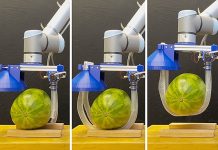
Touchscreens are everywhere today—on our phones, at train stations, in restaurants, and even at the doctor’s office.
But for people who are blind or visually impaired, this technology often comes with barriers.
Electronic braille displays exist, but they can be fragile, easily damaged by dirt or liquid, and difficult to repair.
They also tend to be limited, often showing only one line of braille at a time.
Researchers at Cornell University may have found a way to change that.
By combining the principles of soft robotics with tiny, controlled explosions, they have created a new kind of electronic tactile display that is stronger, cheaper, and easier to maintain than current systems.
Their work, published in Science Robotics, could help make braille more accessible in everyday environments and expand tactile experiences into fields like virtual reality and medical robotics.
The idea started with a simple question: how can you make braille displays more robust? Current electronic braille cells contain dozens of tiny moving parts in just six dots, and a full page of braille can have thousands of dots.
That means thousands of moving parts that can break down.
According to researcher Ronald Heisser, this makes traditional systems bulky, expensive, and often impractical for creating larger, multi-line braille displays—something increasingly in demand as people want to read spreadsheets, edit code, or even look at pictures in braille.
Instead of relying on motors, pumps, or hydraulics, Cornell’s Organic Robotics Lab took a bold new direction.
They used micro-combustion—the ignition of a tiny amount of fuel in a controlled space—to create bursts of energy that push up soft, rubber-like dots. These dots are made from silicone sheets with built-in actuators that can turn inside out, or “evert,” when triggered.
In the latest version of their device, the researchers designed a 10-by-10 array of 2-millimeter-wide actuators.
When a mixture of oxygen and butane ignites, the dots pop up in less than a millisecond and stay in place until a vacuum pulls them back down. Because the actuators are molded directly into silicone sheets, the system avoids the problem of hundreds of delicate parts grinding against each other.
Instead, it’s simpler, more durable, and easier to manufacture.
Durability is one of the biggest advantages. The display is hermetically sealed, meaning dirt, water, and even spilled drinks can’t get inside.
If a silicone sheet wears out, it can be replaced without discarding the entire device. This design could allow braille readers to use the displays in public spaces like museums, restaurants, or sports arenas without worrying about damaging them.
Beyond accessibility, the technology has wide-reaching potential. High-resolution tactile feedback is important in fields like surgery, where a doctor could benefit from more sensitive touch-based feedback, or in robotics, where machines need to mimic human muscle movement.
It could also be used in virtual reality, making digital experiences more immersive by adding the sense of touch.
For Heisser, now a postdoctoral researcher at MIT, the importance of this work also comes back to literacy. “Reading braille is equivalent to literacy,” he said. “Screen readers can help, but they don’t build the same fluency that comes from physically reading.”
By making braille displays stronger, more affordable, and more versatile, this technology could open doors to greater literacy, accessibility, and independence for millions of people around the world.



